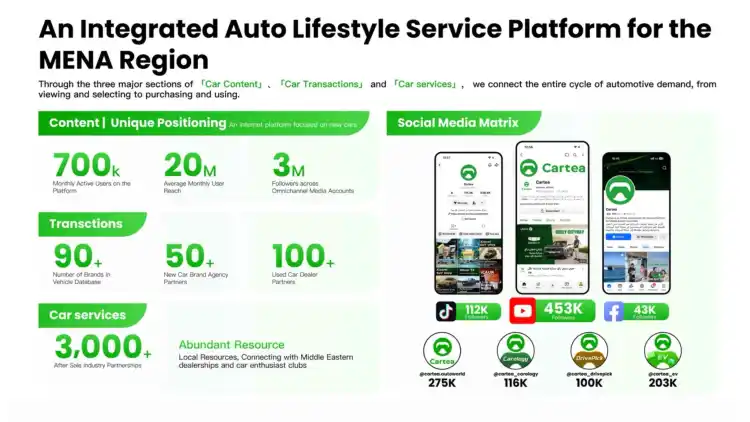As the global automotive industry accelerates its transformation, the Middle East is emerging as one of the world’s most dynamic new markets. Understanding this “new red ocean” — its consumer logic, digital ecosystems, and cultural nuances — has become crucial for automakers seeking to establish a foothold.
Recently, Cartea Automotive Research Institute released its latest report, “The New Marketing Model in the Middle East: The Cartea 3S Marketing Model.” Backed by extensive data and in-depth insights, the report analyzes the latest trends in the Middle Eastern automotive landscape and introduces a new framework designed specifically for this region — the 3S Marketing Model (Social–Search–Sale).
English Version:
Chinese Version:
Redefining Middle Eastern Marketing: From Long Funnels to Fast Conversions
According to the report, the Middle East market has rapidly evolved from being fuel-car dominated to a competitive and diversified battlefield. Japanese and Korean brands still hold large shares, but Chinese automakers are catching up fast, leveraging strengths in intelligent technology, design, and value.
For instance, JetourUAE JetourKSA JetourKuwait JetourQatar JetourOman JetourBahrain JetourEgypt Jetour’s sales in the UAE surged by 212.2% in the first half of 2025, climbing from 23rd to 4th place in brand rankings. The success was largely driven by localized marketing — collaborating with influencers, organizing desert events, and integrating with local communities.
At the same time, consumer behavior in the region has changed dramatically. Today, car buyers rely heavily on social media platforms such as TikTok, Instagram, and YouTube for information, often completing the entire “awareness–interest–decision” journey within these ecosystems.
Traditional linear frameworks like the AISAS model (Attention–Interest–Search–Action–Share) no longer capture the region’s fast-paced decision-making. Instead, Middle Eastern consumers are characterized by shorter, non-linear purchase paths— where attention is sparked through social touchpoints, validation happens through AI or social searches, and conversions occur almost instantly via online or hybrid transactions.
These shifts laid the foundation for Cartea’s 3S Model.
Introducing the Cartea 3S Model — A Marketing Framework Built for the Middle East
Cartea’s 3S Marketing Model distills Middle Eastern consumer behavior into three interconnected stages:
Social Spark, Search Trust, and Sale Certainty.

Social (Social Spark):
Brands ignite awareness and emotional engagement through localized storytelling, influencer collaborations, and creative social campaigns on platforms like TikTok, Instagram, Facebook, and YouTube.
Search (Search Trust):
Once interest is triggered, users seek validation. Through AI-assisted recommendations, Google searches, and specialized auto portals, they verify a brand’s reliability, specifications, and offers — transforming curiosity into trust.
Sale (Sale Certainty):
By integrating online browsing tools, virtual showrooms, and offline test drives, brands can shorten the conversion path and turn engagement into real transactions. Offline experiences and owner stories then feed back into social media, completing the marketing loop.
This non-linear, data-driven model allows automakers to capture attention, build trust, and close sales far more efficiently — perfectly matching the fast, emotion-driven purchase behavior of Middle Eastern consumers.
Data-Backed Insights for Chinese Automakers Going Global
With over 20 million monthly content impressions, 250 local influencers, and 500,000 active users, Cartea stands as the most influential automotive media and service platform in the region. Leveraging a database of more than 90 global brands, Cartea’s 3S Model introduces a set of three key performance indicators for assessing brand effectiveness in the Middle East:
Social Influence Index – Measures a brand’s visibility and engagement across platforms like TikTok and Instagram.
Search Attraction Index – Tracks real consumer interest and online search intensity for specific brands or models.
Sales Conversion Index – Evaluates offline showroom coverage, car show participation, and livestream performance.
The report highlights how Chinese brands are quickly adapting to these dynamics.
KSA CheryQatar CheryBahrain CheryOman CheryUAE CheryKuwait CheryEgypt Chery and Jetour lead social engagement through high-frequency, localized content.
UAE MGKSA MGKuwait MGQatar MGOman MGBahrain MGEgypt MG dominates the sales index, supported by a strong physical dealership network.
UAE ChanganBahrain ChanganEgypt ChanganKSA ChanganKuwait ChanganOman ChanganQatar Changan leverages its EV lineup and extensive channels to sustain growth.
Egypt BYDKSA BYDUAE BYDKuwait BYDQatar BYDOman BYDBahrain BYD and GWM are strengthening their brand image around smart technology and premium value.
These findings demonstrate that Chinese automakers are not only entering the market — they’re reshaping it.
Cartea: The Bridge Between Chinese Brands and Middle Eastern Consumers
As the official media partner of the Chinese Embassy in the UAE and the largest automotive media outlet covering the 2024 Jeddah International Motor Show, Cartea has long been a trusted bridge connecting Chinese innovation with Middle Eastern audiences.
The launch of the 3S Marketing Model is more than just a research achievement — it is a strategic roadmap for global automakers looking to succeed in one of the world’s most promising markets.
It offers a clear message: In the Middle East, the winners will be those who can understand consumers faster, connect social awareness with search validation, and convert engagement into sales with precision.
Through the Cartea 3S Model, Chinese brands now have a tested, data-driven playbook to accelerate their localization, strengthen brand influence, and seize the next wave of automotive growth in the Middle East.







